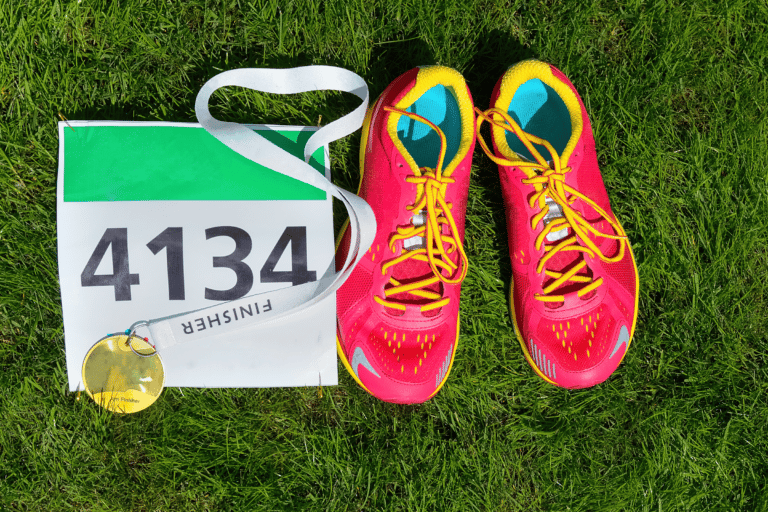Why Do Runners Start at Different Places? (Track Lanes Explained)
Watching a race may be slightly confusing if you’re new to track and field. Why are the runners starting at different places? Isn’t that unfair?
Runners start at different places during track races to compensate for the difference in the distance of their lanes. If the ends of a race track are oval, the outer track lanes equate to a longer distance than the inner track lanes. For this reason, runners in the inner lanes will start further back, and runners in the outer lanes will be moved up.
This only leads to more questions. Is one lane more advantageous than another? Where do the fastest runners end up? Read more to find out.
Why do track runners not start at the same spot?
When watching a high school, collegiate, or Olympic race, you’ll notice that the runners are staggered . This means they aren’t starting at the same spot. Why is that?
Track runners start at different spots to compensate for different lane distances. Runners in more extended lanes are moved up to shorten their overall running distance, whereas runners in the inside lanes are moved back to lengthen their overall running distance.
Simple math dictates that outer lanes are longer because the oval portion of the track is larger. Conversely, this makes the inner lanes shorter because the oval portion of the track is smaller in radius.
By starting runners in different spots that are carefully calculated, every race participant ends up running the same distance.
If starts were not staggered, every lane would run a different length. Inside lanes would have the greatest advantage, and outer lanes would pale in comparison. So it wouldn’t be fair to compare times.
So, to summarize, track runners are staggered to ensure everyone runs the same distance.
Is every lane on a track the same distance?

When observing a basic outdoor track, you may notice that the track is split into eight lanes. Is every one of these lanes equidistant?
No, every lane on a track is a different distance. Outside lanes are longer than inside lanes due to a larger radius at the oval portion of the track.
To elaborate, all eight lanes vary in distance. From the inside moving out, lane distance increases. This means that lane 1 (the innermost lane) is the shortest, and lane 8 (the outermost lane) is the longest.
According to Livestrong, lane two is 407.67 meters, and lane eight is 453.66 meters. A pretty significant difference, right?
This stresses the importance of staggering the starting position of racers to ensure they run the same distance. If runners began in the same spot, the outside runner would have to run nearly 50 meters more!
Does the lane matter in track?
Lanes are different lengths, although all runners run the same distance. Many runners prefer one lane over another; do the lanes matter in track?
No, it has been scientifically proven that the lane does not matter when racing. Claims about certain lanes being superior to others can be boiled down to differences in preferences.
Every lane is the same distance. Everybody runs 200, 400, or 800 meters, whatever the distance may be.
Pseudo-science explains the claims that specific lanes may be better than others. Runners on the outside lanes cannot see their competitors, so they lack the motivation to chase them, or so the saying goes.
In reality, research on random lane assignments has proven that lane assignment has little to no correlation to how fast runners complete the race. It is only preference.
How are runners assigned lanes?
If runners have particular preferences about lanes, it makes sense that all runners would want the most advantageous lane. How are runners assigned lanes?
In the first round of racing, runners are assigned lanes at random. All rounds following the first round place runners in specific lanes based on their times in the previous races.
First-round assignments are always random. This leaves runners with no basis for complaint.
Prior performance, your team, and other factors do not affect where you end up. It’s completely random.
Following the first round, however, viable results can be used to decide where to place runners. Race times are used to place the fastest runners in preferable lanes, whereas the slower runners are stuck with unfavorable lane assignments.
What lane does the fastest runner go in?

While the first round of racing is always subject to random lane assignments, what lane is rewarded to the fastest runners in future races?
The fastest runner is awarded a middle lane, either lanes 4, 5, or 6. These lanes are thought to be the best lanes in track and field.
While it’s been proven that the middle lanes are not actually any faster than other lanes, the preference persists among runners.
The thought process behind this is as follows: runners can see their opponents in the inside lane by being in the middle lane. This elevates their work ethic and gives them an extra drive to chase down the runner in front.
Why do the fastest runners get the middle lanes?
The fastest runners are always awarded the middle lane in races, but why?
The middle lane is preferred in track and field for two reasons. The middle lane allows runners to see competitors in front of them. The middle lane also has a modest turn radius, so runners don’t have to alter their stride when racing.
The fastest runners are awarded the middle lane by excelling in prior races.
By being placed in the middle lane, runners can see the runners in the inner lane. Staggered start positions place the runners on the inside ahead at the start, providing the middle lane runners with a target to catch.
Being in the middle lane also provides a very slight, if even existent, ergonomic advantage. Runners placed on the inside lane suffer from an extremely tight turn radius which has the potential to slow them down. Runners in the middle lane don’t have to worry about this.
Why do some runners start in the back?
Inside lanes start what seems like miles behind the outer lanes. Why is this?
Runners in the inside lanes start much further back than runners in the outer lanes to make up for the difference in distance. Inner lanes are approximately 40 to 50 meters shorter than outside lanes, so runners are placed further back to make the running distance equivalent.
Inner lanes start further back to make up for the difference in distance between the inner and outer lanes.
Start positions move increasingly forward as runners get to the outside of the track. The innermost lane is set the furthest back, while the outermost lane is bumped the furthest forward.
Which lane is best in track?
All things considered, what is the best lane when running a track race?
While it is a preference, the middle lanes are considered the best. Research does not show significant differences between any one lane, although inner and outer lanes may be slightly disadvantaged depending on the race length.
Middles lanes are considered the best for their modest turn radius and ability to chase down competitors. Of course, this is purely mental. Research has disproven any real basis for this claim.
Depending on the length of the race, the inner and outer lanes see small marginal differences. For example, in the 200-meter sprint, the outer lane is 0.2 seconds faster than the inner lane. This results from reduced ergonomic efficiency in the innermost lane.
In the 800-meter race, the outer lane is slightly slower due to the necessity to lane break following the first lap.
No lane is superior to another. Middle lanes are widely considered the best, but not for any real reasons.




![What Is a Turkey Trot? [A 5k Race Before You Stuff Your Face!]](https://yournext.run/wp-content/uploads/2023/01/what-is-a-turkey-trot_featured-768x512.png)

